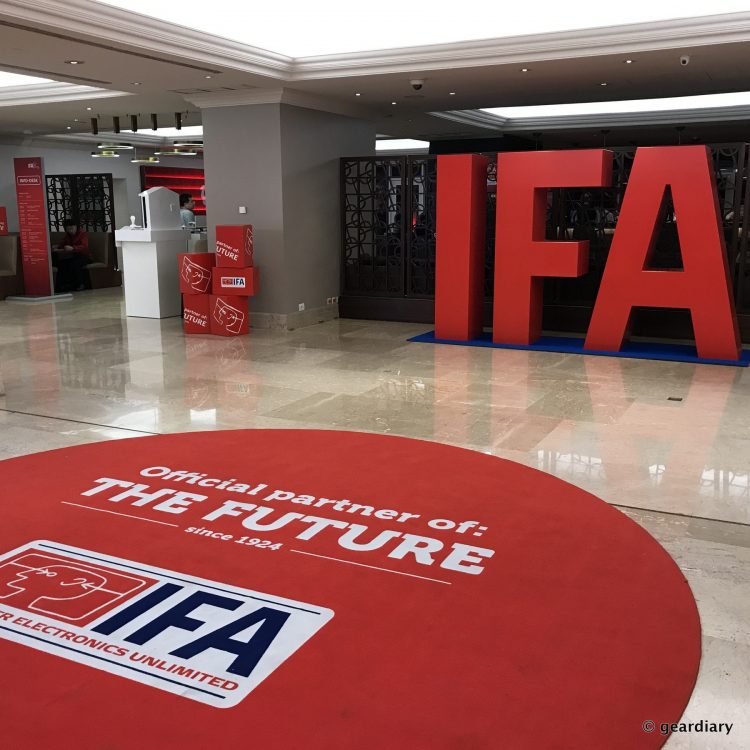For the past few years, I’ve been one of a select group of international journalists invited to the IFA Global Press Conference. A warm-up, if you will, for the yearly IFA convention held in Berlin, the press conference is a great time to check up on the current and future status of the global electronics market.

While a series of sessions consisting of a bunch of marketing statistics might seem dry at first, there were some fascinating nuggets to glean that I thought you all might enjoy hearing…
Granted, this particular slide’s set of stats is for Europe, but did you know that in 2016, 29.8 million headphones were sold in Europe, along with 13.3 million Bluetooth speakers, 2.2 million VR glasses, and 1.8 million drones? Since there are approximately 743 million people living in Europe, there is plenty of room for these markets to grow.

The slide below shows that 89% of audio streaming capable products use Bluetooth as their connectivity standard. But something that was mentioned at the conference that I’d never heard (or really thought about) was that Bluetooth wasn’t some government mandated standard like microUSB was.

Bluetooth’s use and adaptation were something that organically happened after Ericsson realized what they had was special and needed to be shared, and they then invited other companies including Nokia, IBM, and Toshiba to take part in its open source use on an unrestricted frequency range (you can read more about it here).
Companies working together to offer compatible products and consumers enjoying the ease with which those products could be linked and used together is what made Bluetooth the standard. You don’t have to be a stats geek to think that’s kind of interesting — a completely Darwinian example of something strong evolving into the standard.
Also interesting is taking a look at the evolution of connected sound, or how we listen to the sound produced by our electronics and the capabilities of the speakers producing that sound. First, we connected dumb (as opposed to smart) speakers to computers via cables, then it was the use of docking speakers which were compatible only with the specific devices they were meant to support. How many of you bought or still own a docking speaker? I did and I do.
Then came mini speakers which connected via 3.5mm cables to the music source … and then Bluetooth exploded and took over. It’s interesting to me that while other ways of listening wirelessly are available (e.g., NFC, Apple Airplay), we can’t help but come back to the fact that Bluetooth is the standard. But what’s next? Smart speakers.

We’re seeing the evolution of smart speakers occur right now with Google Home and the Amazon Echo; these aren’t only wirelessly connected speakers, they are also intelligent, connected personal assistants.

GfK Global, predicts that intelligent connectivity is going to become a feature in even more audio products. How do you feel about that? Do you like asking Alexa to play music without you having to search for it yourself? Would you like to see connectivity in even more of the products you use around your home — your washer and dryer, for instance, or your stove? We’re already seeing this in our refrigerators.
The fact is that voice interaction (recognition & control) is all around us, and it is only going to become more common and standard.

Something I had never really considered: the creation of smartphones was directly responsible for the development of several sub-markets that include: mobile payments, virtual and augmented reality, smart homes, connected and autonomous vehicles, and wearables.
It’s kind of mind-blowing when you consider that many of these products weren’t even conceivable much less available before smartphones became so ubiquitous; these sub-markets very existence is traceable to the evolution of smartphones and people wanting them to be able to do even MORE.

In the past few years, there’s been an explosion in connected smart home devices — everything from deadbolts to vacuum cleaners to doorbells to coffee makers to home air cleaners and fans. When these products work as expected, they add convenience and value to their owners’ lives; once you’ve got one smart product in your home, you can’t help but want more.

Michael Zöller, Samsung’s Vice President, Head of Visual Display in Europe, came out to talk about their new Frame television (it displays art on your wall when it’s not serving as a television). He said that “the discussion on TV picture quality will become obsolete as more people get better televisions,” which makes sense. Then we dug down deep into some television stats and insights into new patterns of use with Paul Gray from IHS Technology.
As we’ve all noted, larger and better HD and UHD televisions are becoming less expensive and more available to everyone, but what if televisions could do even more than just stream content? The future of television will be “driven by new content and access to the new content.” One of the possible uses for televisions included school lessons for children who are home sick, medical care apps for those who need them — in other words, there is no reason that televisions should only be a means of entertainment, they can, should, and eventually will provide support for people in their daily life.

How do you feel about the connectivity of so many things? Does it raise privacy issues for you, or do you feel that we’ve already given up any hope for that? Do you feel like the convenience brought by products such as smartTVs and connected home products mitigates any of those concerns? Do tell! 🙂